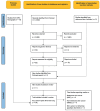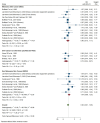Risk of Skin Cancer in Workers Exposed to Diesel Exhaust: A Systematic Review and Meta-Analysis of Cohort Studies
- PMID: 38686576
- PMCID: PMC11181223
- DOI: 10.23749/mdl.v115i2.15569
Risk of Skin Cancer in Workers Exposed to Diesel Exhaust: A Systematic Review and Meta-Analysis of Cohort Studies
Abstract
Background: Our objective was to study the association between occupational exposure to diesel exhaust (DE) and skin cancer.
Methods: A systematic review following STROBE guidelines and PECOS criteria was conducted to identify cohort studies describing the association between occupational DE exposure and the risk of skin cancer. We extracted 12 independent risk estimates for melanoma skin cancer (MSC), 8 for non-melanoma skin cancer (NMSC), and 3 for skin cancer not otherwise specified (SC-NOS). Random effects meta-analyses were performed, site-specific and stratified by geographic region and quality score. 95% confidence intervals (CI) were reported. Between-study heterogeneity and potential publication bias were investigated.
Results: There was no overall evidence of an increased risk of MSC [RR=0.90, 95% CI: 0.73-1.11; I2=92.86%, 95% CI: 82.83-97.03%], NMSC [RR=1.04, 95% CI: 0.88-1.23; I2=60.79%, 95% CI: 0-87.34%] or SC-NOS [RR=0.72, 95% CI: 0.54-0.97; I2=26.60%, 95% CI: 0-94.87%] in workers exposed to DE. No difference between low-quality and high-quality studies was found. A stratified analysis by geographical region did not reveal any significant differences. There was no evidence of publication bias.
Conclusions: No evidence of an association between skin cancer and occupational DE exposure was found. Residual confounding and other sources of bias cannot be ruled out.
Conflict of interest statement
PB acted as expert witness in litigation concerning diesel exhaust exposure and gastrointestinal cancers, unrelated to the present work. No conflicts were reported by the other authors.
Figures











Similar articles
-
Risk of Gynecological and Breast Cancers in Workers Exposed to Diesel Exhaust: A Systematic Review and Meta-Analysis Of Cohort Studies.Med Lav. 2024 Jun 21;115(3):e2024011. doi: 10.23749/mdl.v115i3.15568. Med Lav. 2024. PMID: 38922840 Free PMC article.
-
Occupational-related exposure to diesel exhaust and risk of leukemia: systematic review and meta-analysis of cohort studies.Int Arch Occup Environ Health. 2024 Mar;97(2):165-177. doi: 10.1007/s00420-023-02034-y. Epub 2023 Dec 24. Int Arch Occup Environ Health. 2024. PMID: 38142415
-
A meta-analysis of bladder cancer and diesel exhaust exposure.Epidemiology. 2001 Jan;12(1):125-30. doi: 10.1097/00001648-200101000-00021. Epidemiology. 2001. PMID: 11138807
-
The Diesel Exhaust in Miners study: a nested case-control study of lung cancer and diesel exhaust.J Natl Cancer Inst. 2012 Jun 6;104(11):855-68. doi: 10.1093/jnci/djs034. Epub 2012 Mar 5. J Natl Cancer Inst. 2012. PMID: 22393209 Free PMC article.
-
Occupational exposure to diesel exhaust and lung cancer: a meta-analysis.Am J Public Health. 1999 Jul;89(7):1009-17. doi: 10.2105/ajph.89.7.1009. Am J Public Health. 1999. PMID: 10394308 Free PMC article.
Cited by
-
Incidence and risk factors for skin cancer after heart transplantation: a systematic review and meta-analysis.Arch Dermatol Res. 2025 Jan 15;317(1):248. doi: 10.1007/s00403-024-03759-7. Arch Dermatol Res. 2025. PMID: 39812815 Free PMC article.
References
-
- IARC: diesel engine exhaust carcinogenic. Cent Eur J Public Health. 2012;20(2):120–138. - PubMed
-
- Guo J, Kauppinen T, Kyyrönen P, et al. Risk of esophageal, ovarian, testicular, kidney and bladder cancers and leukemia among finnish workers exposed to diesel or gasoline engine exhaust. Int J Cancer. 2004;111(2):286–92. Doi: 10.1002/ijc.20263. - PubMed
Publication types
MeSH terms
Substances
LinkOut - more resources
Full Text Sources
Medical

